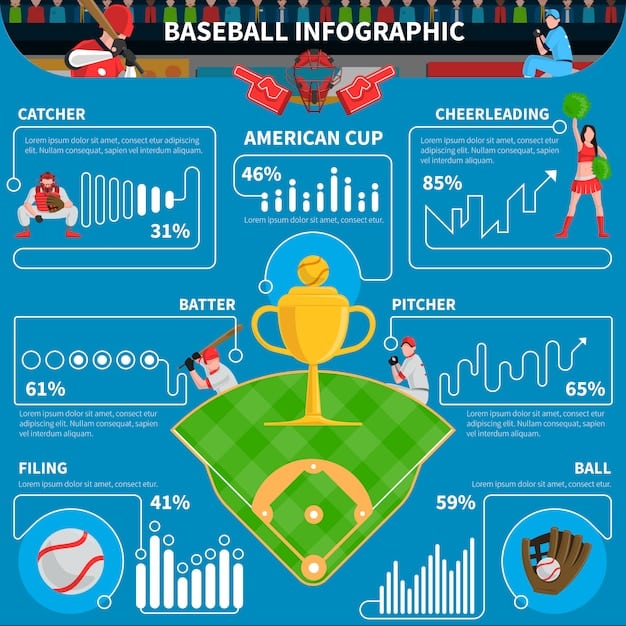MLB Data Analytics: 8% Win Rate Boost by 2025?

The shift to data analytics in MLB front offices is significantly impacting team performance, with a projected 8% increase in win rates by 2025 for teams embracing advanced statistical methodologies, optimizing player acquisition, development, and in-game strategies for a competitive edge.
Is the shift to data analytics in MLB front offices increasing team win rates by 8% in 2025? This ambitious question delves into one of baseball’s most transformative trends. As teams increasingly leverage sophisticated data models, the traditional methods of evaluating talent and crafting strategy are undergoing a significant revolution. We’ll explore the projections, the methodologies, and the tangible impacts of this analytical revolution shaping the future of America’s pastime.
The Foundational Shift: From Gut Instinct to Data-Driven Decisions
For decades, major league baseball was largely governed by scouts’ intuition, managers’ gut feelings, and an almost mythical understanding of “the game.” Decisions on who to draft, who to play, and how to approach an opposing batter were often rooted in subjective observation and anecdotal experience. However, the early 2000s marked a pivotal turning point, initiated most famously by the Oakland Athletics and their “Moneyball” philosophy.
This nascent analytical approach, while rudimentary by today’s standards, demonstrated the power of objective data in identifying undervalued assets and constructing competitive teams on a budget. It proved that a deeper dive into sabermetrics—the empirical analysis of baseball—could unlock efficiencies and advantages previously overlooked. This concept, initially met with skepticism, slowly but surely began to permeate front offices across the league.
Evolution of Analytical Tools and Personnel
The journey from basic on-base percentage (OBP) to intricate predictive models has been swift and profound. Early analytics teams were often small, composed of a few statistically-minded individuals working in relative isolation. Today, MLB perennial contenders and even rebuilding franchises boast dedicated analytics departments, staffed by PhDs in statistics, computer science, and even astrophysics.
- Dedicated Data Scientists: Teams now employ full-time data scientists who build complex algorithms to model player performance, health, and potential.
- Advanced Scouting Software: Proprietary software platforms integrate vast datasets, including Statcast, pitch tracking, and biomechanical data, providing real-time insights.
- In-Game Strategy Portals: Managers and coaches have access to tablets and systems that offer data-driven recommendations during games, from defensive shifts to pitching matchups.
The Integration of Technology and Human Expertise
While data provides an undeniable edge, the human element remains critical. The most successful organizations understand that analytics is a tool to augment, not replace, traditional baseball acumen. Coaches and players still need to understand, interpret, and execute the data’s findings on the field. The art of baseball managing now involves translating complex statistical outputs into actionable strategies that resonate with a diverse group of athletes.
The synergy between seasoned baseball minds and analytical savants creates a more comprehensive and refined decision-making process. This collaboration pushes the boundaries of what’s possible, moving beyond simple metrics to explore nuanced aspects of the game, such as pitch tunneling, launch angle optimization, and advanced baserunning metrics. The initial resistance from traditionalists has largely given way to a collaborative environment where data informs every level of the organization.
Advanced Metrics: Unlocking Hidden Value and Performance
The backbone of the analytical revolution in MLB is the proliferation of advanced metrics. Beyond the traditional batting average, home runs, and RBIs, new statistics have emerged that offer a more granular and accurate picture of player value and team performance. These metrics often account for factors like park effects, defensive alignment, and situational leverage, providing a more “true” measure of contribution.
Consider expected outcomes (xStat metrics) that predict a player’s performance based on the quality of contact for hitters or the movement and velocity for pitchers. These are not merely descriptive; they are predictive, helping front offices identify players whose actual performance might be masking underlying talent or vice-versa.
Key Advanced Metrics in Modern Baseball
The landscape of baseball statistics has dramatically broadened, providing richer insights.
- WAR (Wins Above Replacement): This comprehensive metric attempts to quantify a player’s total contribution to their team in terms of wins, accounting for offensive, defensive, and baserunning value compared to a hypothetical replacement-level player.
- xFIP (Expected Fielding Independent Pitching): Instead of just ERA, xFIP estimates a pitcher’s true ability by focusing on outcomes they largely control (strikeouts, walks, hit-by-pitches, and fly balls), normalizing for the league average home run rate.
- BABIP (Batting Average on Balls In Play): This metric helps evaluate the luck factor for hitters and pitchers, indicating how often batted balls turn into hits, excluding home runs. A player’s BABIP can highlight whether they are underperforming or overperforming their true talent level due to factors outside their control.
- Launch Angle and Exit Velocity: These Statcast metrics measure the angle at which a ball leaves the bat and its speed, offering critical insights into a hitter’s power potential and ability to hit for extra-base hits.
The Impact on Player Evaluation and Acquisition
The shift to advanced metrics has reshaped how teams scout, draft, and sign players. Instead of relying solely on traditional scouting reports, analysts now blend quantitative data with qualitative observations. This blended approach allows teams to: identify players with untapped potential based on underlying skills that traditional statistics might miss; avoid overpaying for players whose performance is artificially inflated by “lucky” stretches; and customize player development plans based on specific data-driven insights into their strengths and weaknesses.
For example, a pitcher with a high ERA but an excellent xFIP might be a prime acquisition target, suggesting they’ve been unlucky and are due for positive regression. Similarly, a hitter with a low batting average but consistently high exit velocities and optimal launch angles could be a breakout candidate. This strategic use of data minimizes risk and maximizes the potential return on investment in player personnel.
Strategic Applications: From Scouting to In-Game Management
The widespread adoption of data analytics is not confined to player evaluation. Its influence now permeates every facet of a major league organization, from the initial scouting of amateur talent to the real-time strategizing during a tense ninth inning.
Front offices leverage sophisticated predictive models to project the future performance of draft prospects and international signees, going beyond high school or college stat lines to analyze underlying mechanics, batted ball profiles, and athletic traits. This granular approach helps teams make more informed decisions about which players to invest in and how to allocate crucial development resources. The goal is to identify systemic efficiencies and competitive advantages through detailed data analysis at every stage of the baseball pipeline.
Optimizing Player Development
Once a player is in the system, analytics plays a crucial role in their development. Teams use biomechanical data from high-speed cameras and motion sensors to break down a player’s movements, identifying inefficiencies in their swing or pitching delivery. This allows for highly personalized coaching interventions that target specific areas for improvement, based on objective data rather than generalized advice.
- Personalized Training Regimens: Data helps tailor strength and conditioning programs, focusing on individual player needs and injury prevention.
- Skill Refinement: Pitchers can refine their pitch arsenal by analyzing spin rates, velocity, and movement, while hitters can adjust their swing paths for optimal launch angles and exit velocities.
- Mental Performance: Data can also inform psychological approaches, by identifying patterns in performance under pressure and developing strategies to enhance mental toughness.
In-Game Strategy and Tactical Shifts
The dugout has transformed into a command center. Managers and coaches, armed with real-time data, are making more informed decisions about defensive shifts, pitching matchups, and pinch-hitting situations. Algorithms can quickly process vast amounts of historical data and current game situations to suggest optimal strategies.
For instance, data drives defensive shifts, positioning fielders precisely where a specific batter is most likely to hit the ball. Pitching coaches utilize charts showing effective pitch sequences against particular hitters, based on their historical plate discipline and swing profiles. Bullpen management is now a complex actuarial science, with data guiding decisions on which relievers to use in specific high-leverage situations to maximize win probability. This dynamic application of data provides an adaptive edge in the heat of competition.

The 8% Projection: Data, Trends, and Future Outlook
The notion of a specific 8% increase in win rates for teams fully embracing data analytics by 2025 is a bold one, but it reflects a growing consensus within the industry. This projection isn’t pulled from thin air; it’s based on extrapolations from current trends, expert analysis, and the undeniable success of analytically-driven organizations.
Teams that were early adopters of advanced analytics, such as the Dodgers, Astros, and Rays, have consistently outperformed their payrolls or maintained sustained excellence. Their success stories serve as compelling case studies for the benefits of a data-first approach. The 8% figure represents the anticipated cumulative impact of incremental gains across various facets of team operations, compounded over time.
Factors Contributing to the Projected Increase
Several converging factors are expected to drive this potential increase:
- Widespread Adoption of Statcast: All 30 teams now have access to rich Statcast data, but the differential lies in how effectively teams can analyze and act upon it.
- Improved Data Infrastructure: Teams are investing heavily in robust data warehouses and visualization tools, making insights more accessible and actionable.
- Integration of AI and Machine Learning: Advanced algorithms can identify patterns and predict outcomes with greater accuracy than human analysis alone, leading to more optimized decisions.
- Specialized Analytical Talent: The talent pool for baseball analytics is deepening, with more sophisticated minds entering the field.
Challenges and Limitations
Despite the promise, there are inherent challenges. One major hurdle is the human element: convincing players, coaches, and traditional scouts to fully embrace and trust data-driven recommendations. Another is the ever-evolving nature of the game; what works today might be countered tomorrow, requiring constant innovation in analytical approaches. Furthermore, the “secret sauce” of one team’s analytical success is rarely transferable without significant adaptation.
The competitive landscape also presents limitations. As more teams adopt advanced analytics, the marginal gains become smaller. The 8% increase might represent the maximum potential for teams that are truly at the cutting edge, while others might achieve less significant, but still meaningful, improvements. The goal shifts from simply using data to using it more intelligently and creatively than the competition.
Case Studies: Analytical Success Stories in MLB
To truly understand the impact of data analytics, it’s essential to examine teams that have excelled by integrating these methodologies into their core operations. These organizations aren’t just dabbling in data; they’ve built their entire philosophy around it, from minor league development to major league strategy. Their success offers a tangible demonstration of how analytics translates into wins.
The common thread among these teams isn’t necessarily the largest payroll, but rather a commitment to continuous improvement through objective analysis. They’ve fostered cultures where data is valued, openly discussed, and applied strategically across all departments. This systemic embrace of analytics sets them apart.
The Los Angeles Dodgers: A Model Franchise
The Dodgers are often cited as a prime example of an analytically driven juggernaut. While they possess a large payroll, their success is rooted in their ability to maximize value at every level. Their farm system consistently produces top-tier talent, a testament to their data-informed scouting and player development. They use advanced metrics to identify undervalued players in trades and free agency, and their in-game strategic decisions are highly optimized by real-time data.
Their player acquisition strategy frequently targets players with strong underlying metrics but perhaps unfulfilled potential. Their development staff then leverages data from pitch design labs and biomechanical assessments to help players unlock that potential. This holistic, data-centric approach has resulted in multiple World Series appearances and a sustained period of competitive dominance, proving that analytics can be a powerful engine for success even for high-spending teams.
The Tampa Bay Rays: Punching Above Their Weight
The Rays are perhaps the quintessential “Moneyball 2.0” team, consistently competing for postseason berths with one of the lowest payrolls in baseball. Their strength lies in their extraordinary ability to identify, develop, and maximize talent through rigorous analytical processes. They are renowned for their innovative bullpen management, their ability to find gems in the draft and international markets, and their sophisticated defensive alignments.
Tampa Bay’s success is largely attributed to their aggressive embrace of sabermetrics and their willingness to challenge traditional baseball conventions. They are often at the forefront of new analytical trends, experimenting with novel strategies like the “opener” (starting a reliever for the first inning) and optimizing pitch usage based on data. Their ability to do more with less serves as a powerful validation of the efficacy of a deep analytical commitment.

Future Implications: The Ever-Evolving Landscape of Baseball Analytics
The analytical arms race in MLB is far from over. As technology advances and data becomes even richer, the strategies and insights derived from analytics will continue to evolve, pushing the boundaries of competitive advantage. The future promises even more sophisticated predictive models, deeper integration of artificial intelligence, and a greater emphasis on personalized player development and optimization.
The 8% win rate increase projection by 2025 serves as a benchmark, but the true impact might extend even further as teams refine their analytical capabilities. The game will likely continue to adapt, with rule changes and strategic adjustments coming as a direct response to data-driven innovations.
Emerging Analytical Frontiers
What’s next for baseball analytics? Several areas are expected to see significant growth:
- Biometric Data and Injury Prevention: Increased use of wearable technology and physiological data to monitor player fatigue, optimize training, and predict injury risk.
- Mental and Cognitive Analytics: Tools to measure and improve decision-making under pressure, pitch recognition, and overall mental fortitude.
- Sleep and Recovery Optimization: Data-driven insights into how sleep patterns and recovery protocols impact on-field performance.
- Virtual Reality (VR) and Augmented Reality (AR): Immersive training environments that simulate game situations, allowing players to practice decision-making in a data-rich context.
The Human Element Amidst Data Saturation
As data becomes more ubiquitous, the ability to interpret it effectively and translate it into human action will become even more critical. The role of the “baseball person” will shift towards understanding data, communicating its insights to players, and fostering a culture of continuous learning. While data can tell you what should happen, it’s still up to the players and coaches to make it happen on the field.
The game will remain dynamic, a blend of predictable patterns and unpredictable human moments. The most successful teams will be those that can master the art of combining cutting-edge analytics with the intangible qualities of teamwork, leadership, and athletic execution. The forecast of an 8% win rate increase is not merely a statistical prediction; it’s a testament to the ongoing evolution of MLB as a science, as much as it is an art.
| Key Point | Brief Description |
|---|---|
| 📊 Data-Driven Shift | MLB teams are moving from intuition to advanced analytics for better decision-making. |
| 📈 Advanced Metrics Impact | New stats like WAR and xFIP offer deeper player evaluation and strategic insights. |
| 🚀 Projected Win Increase | The 8% win rate boost by 2025 is feasible due to enhanced analytical sophistication. |
| 💡 Future Frontiers | Biometrics, AI, and VR will further refine analytics, maintaining competitive advantages. |
Frequently Asked Questions About MLB Analytics
▼
Sabermetrics is the empirical analysis of baseball, especially baseball statistics that measure in-game activity. It seeks to objectively analyze and evaluate baseball performance, often going beyond traditional statistics to find new insights and better predict future outcomes. It encompasses a wide range of analytical approaches, from basic calculations to complex predictive modeling.
▼
Statcast provides granular, real-time data on every play, including pitch velocity, spin rate, exit velocity, launch angle, and player movements. This data helps teams optimize defensive positioning (shifts), inform pitcher-hitter matchups, guide pitch selection, and refine player development strategies, ultimately allowing for more precise in-game adjustments and player evaluation.
▼
Absolutely. While data analytics provides invaluable objective insights, scouts remain crucial. They evaluate intangible qualities like leadership, makeup, and athleticism that data struggles to capture. The most effective front offices blend data analysis with traditional scouting to create a comprehensive player evaluation system, ensuring a holistic understanding of talent and potential.
▼
Teams use analytics for injury prevention by monitoring player workloads, biomechanical stresses, and recovery metrics. Data from wearables, pitch tracking, and training regimens helps identify patterns that may lead to injury. This allows for personalized conditioning, adjusted training schedules, and early intervention, aiming to keep players healthy and performing at their peak.
▼
Expected Batting Average (xBA) is a Statcast metric that estimates a hitter’s batting average based on the quality of contact, specifically exit velocity and launch angle, taking into account the type of batted ball. It aims to eliminate the influence of luck (like defensive positioning or fluky hits) to give a truer measure of how often a player should be getting a hit.
Conclusion
The trajectory of Major League Baseball is undeniably shaped by the relentless march of data analytics. While the precise 8% increase in win rates by 2025 remains a dynamic projection, the evidence overwhelmingly supports the transformative power of these methodologies. From optimizing player acquisition and development to revolutionizing in-game strategy, data-driven decisions now underpin the success of leading franchises. As technology continues to advance, the symbiotic relationship between human expertise and analytical insights will only deepen, ensuring that baseball remains a captivating blend of skill, strategy, and increasingly, science. The pursuit of even marginal advantages through data will continue to propel teams forward, redefining the very essence of competitive baseball.





